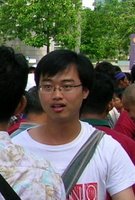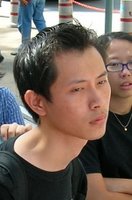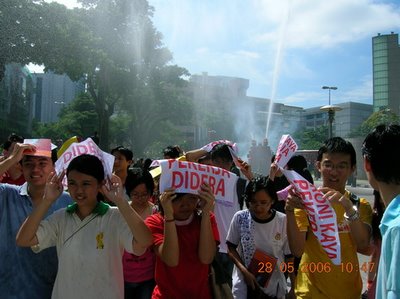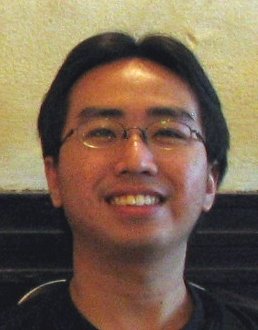SUHAKAM Public Inquiry on "Bloody Sunday" - Day 3
Watching Brief with Observer Status:
1. Chan Weng Keng - Bar Council Legal Aid Centre (KL)
2. Edward Saw Keat Leong - Bar Council
3. Superintendent Rusli bin Ahmad - Secretariat of IGP (Inspector General of Police)
4. Mohd Radzi Harun - Attorney General’s Chamber
Watching brief:
1. Sheena - Bar Council Legal Aid Centre (KL)
2. Ramesh Sivakumar - Bar Council Legal Aid Centre (KL)
3. Chang Lih Kang - SUARAM
Today’s witnesses:
1. Lee Huat Seng
2. Lua Khang Wei
3. Dr. Dzulhelmy bin Sulaiman
4. Mohd Hafizh Mohd Mokhtar
5. Andrew Ong Kok Heng
6. Lai Chee Sen
7. Lee Khai Loon
8. Lim Hong Siang
9. Soh Sook Hwa
Video clip showed FRU hit protestors brutally
Nine witnesses were called to testify in front of the inquiry panel today.
8th witness: I was hit by police on my forehead. FRU hit me from behind using baton
 As one of the victims of police brutality, Lee Huat Seng, a fresh graduate from Universiti Sains
As one of the victims of police brutality, Lee Huat Seng, a fresh graduate from Universiti Sains
Lee Huat Seng (hereinafter referred to as Huat Seng) was retreating peaceably with his friends after the water cannon were unleashed. While they were walking slowly towards the Public Bank building, several FRU came from behind and pushed them by their shields. Huat Seng said he kept telling the FRU personnel that they will leave, but they did not bother. The FRU personnel hit him several times on his back by baton because he was standing at the outermost of the group.
Huat Seng denied that he has obstructed the police because people had to walk gingerly as the floor was wet and slippery due to the water cannon. According to Huat Seng, after he was hit by FRU personnel from behind, a policeman without uniform came up to him and hit him on his forehead with empty hand. He fell on the ground due to the hitting.
Huat Seng later sought medical assistance in Hospital KL. When asked by the panel why he did not lodge a police report after the incident, Huat Seng told them that he has no faith in police anymore.
Earlier, consistent with other protestors, Huat Seng told the inquiry panel that he could not hear any warning from the police before the water cannon were unleashed.
9th witness: I tried to help my friend, but I was hit too
 Lua Khang Wei, administrative secretary of the Selnagor Hokkien Association is the 9th witness of the public inquiry. In the pictures shown to the panel members earlier, Lua Khang Wei (hereinafter referred to as Lua) was seen bleeding profusely on his right cheek.
Lua Khang Wei, administrative secretary of the Selnagor Hokkien Association is the 9th witness of the public inquiry. In the pictures shown to the panel members earlier, Lua Khang Wei (hereinafter referred to as Lua) was seen bleeding profusely on his right cheek.
Similar to all other protestors who have testified in front of the inquiry panel, Lua could not hear what the police was trying to say before the water cannon were unleashed. After he was drenched by the water cannon, Lua left the scene and moved towards the bus stop along Jalan Ampang.
However, Lua went back to assist his friends, who were being intimidated and hit by the police while retreating. Lua saw a number of FRU personnel pushed his friends from behind and Lee Huat Seng (witness 8) was hit by baton. He also saw Lee Huat Seng was being hit on forehead by a policeman without uniform. While Lua was trying to lift Lee Huat Seng who was beaten to the ground, he was hit by the FRU personnel too. He could not recall how many times he was hit, but he told the inquiry panel that his right arm was in extreme pain.
In the melee, Lua’s spectacles fell and cut his right cheek. He bled profusely because of the cut. He was later sent to Hospital KL for medical treatment.
10th witness: Injury suffered by Lee Huat Seng could be life threatening if greater force were used
Dr. Dzulhelmy bin Sulaiman is the doctor who treated Lee Huat Seng and Lua Khang Wei in Hospital KL on 28 May 2006. Dr. Dzulhelmy bin Sulaiman (hereinafter referred to as Dr. Dzulhelmy) is currently a medical doctor in Emergency Unit of Hospital KL.
Dr. Dzulhelmy admitted that he only examined Lee Huat Seng’s forehead, because Lee only complained about the pain on his forehead. He found reddish mark on Lee Huat Seng’s forehead and the patient was in pain. The injury was caused by a heavy hit. According to Dr. Dzulhelmy, the injury suffered by Lee Huat Seng was considered light, but it could be life threatening if greater force were used on the same spot.
Besides, Dr. Dzulhelmy also examined Lua Khang Wei. He found that Lua Khang Wei was in pain on his right shoulder. Dr. Dzulhelmy also found reddish mark on Lua’s shoulder and a scratch on his right cheek. However, the movement of Lua’s right hand was normal.
As told by Lua, his right cheek was cut by his rimless lens and his right shoulder was hit by baton. Dr. Dzulhelmy testified that the injuries were consistent with those inflicted by baton and rimless lens.
11th witness: An unfortunate man was held and beaten up by a team of FRU personnel
 Mohd Hafizh bin Mohd Mokhtar is the 11th witness of the public inquiry. He is a journalist with Suara Keadilan. Mohd Hafizh (hereinafter referred to as Hafizh) has taken some pictures, which includes those showing Zahir Hassan was being kicked by FRU personnel.
Mohd Hafizh bin Mohd Mokhtar is the 11th witness of the public inquiry. He is a journalist with Suara Keadilan. Mohd Hafizh (hereinafter referred to as Hafizh) has taken some pictures, which includes those showing Zahir Hassan was being kicked by FRU personnel.
Besides, Hafizh’s pictures also showed an unknown protestor was being surrounded by a number of FRU personnel and was being hit brutally by the butt of a tear gas launcher (pic).
12th witness: I saw Zahir Hassan being kicked by several FRU personnel
The next witness, Andrew Ong Kok Heng is also a journalist. Andrew Ong Kok Heng (hereinafter referred to as Andrew) is currently working with an online news website, Malaysiakini.
Andrew has taken more than 100 photographs, but part of it was corrupted. Nevertheless, his photographs shown to the panel were ample to tell the chronology of Zahir Hassan being kicked by FRU personnel.
Andrew told the inquiry panel that he saw Zahir was trying to shield his daughters before the FRU personnel hit him. He was being kicked by several FRU personnel for at least 3 times, according to the witness. One of the pictures has clearly shown that a FRU personnel’s leg appeared near Zahir’s crotch.
13th witness: I was shocked when I saw Amran
Lai Chee Sen, a temporary teacher in a secondary school was called as the 13th witness of the inquiry. Lai Chee Sen (hereinafter referred to as Lai) has taken some photographs and few short video clips on the 28 May 2006.
Lai told the panel members that he saw Lee Huat Seng was being hit by FRU personnel. He showed a few video clips to the inquiry panel. One of the clips has clearly shown a FRU personnel swung his baton and hit Lee Huat Seng’s waist. This was followed by another attack by a different police officer (without uniform) who struck Lee Huat Seng on the left side of his forehead.
Lai also told the inquiry panel that he was shocked when he saw the “bloody” Amran after he crossed Jalan Ampang.
14th witness: I was hit by police and my glasses was broken
 Lee Khai Loon, a full time staff of a youth organization is the 14th witness of the inquiry. Lee Khai Loon (hereinafter referred to as Khai Loon) was a victim of police brutality.
Lee Khai Loon, a full time staff of a youth organization is the 14th witness of the inquiry. Lee Khai Loon (hereinafter referred to as Khai Loon) was a victim of police brutality.
Khai Loon told the inquiry panel that he did not hear any warning from the police before the water cannon were unleashed. When he was dispersing with his friends, Khai Loon saw Lee Huat Seng was being hit by FRU personnel. He was just behind Lee Huat Seng when the incident happened.
Seconds later, Khai Loon was also being hit by a hard object. He told the panel that the hitting came from behind when he was moving. His glasses were broken and he could not see things clearly. Khai Loon told the panel that his friends guided him to cross the main road (Jalan Ampang).
15th witness: FRU said “Kalau kamu ambil gambar lagi, saya akan hancur kamera kamu!”
Journalist of an online news website, Merdekareiew, Lim Hong Siang was called to testify as the 15th witness of the public inquiry.
Lim Hong Siang (hereinafter referred to as Lim) showed some photographs which were taken by him during the peaceful assembly on 28 May. He told the panel that the crowd was dispersing in a very peaceful manner after the water cannon were unleashed. They moved gingerly because the floor was wet and slippery. The entrance of Suria KLCC was blocked by the police, and the only way to disperse seemed to be crossing the main road – Jalan Ampang.
However, the FRU personnel acted rudely towards the crowd. When Lim was trying to take picture of the FRU’s brutality, he saw two FRU personnel came to him in an intimidating manner. He then decided to run away from them. While running, Lim was kicked by the FRU personnel on his buttock. He then shouted to the FRU “Media pun kamu pukul ke?” (You hit even journalist?)
The FRU warned him:“Kalau kamu ambil gambar lagi, saya akan hancur kamera kamu!” (If you continue to take picture, I will destroy your camera!)
16th witness: I saw few of my friends being beaten up by the FRU
 Soh Sook Hwa, the former secretary of Malaysia Youth and Democratic Movement (DEMA), was called to testify in the inquiry as the 16th witness. DEMA is a student and youth organization which is part of the PROTES coalition.
Soh Sook Hwa, the former secretary of Malaysia Youth and Democratic Movement (DEMA), was called to testify in the inquiry as the 16th witness. DEMA is a student and youth organization which is part of the PROTES coalition.
Soh Sook Hwa (hereinafter referred to as Soh) told the inquiry panel that she did not hear any warning from the police throughout the demonstration. After the water cannon were unleashed, Soh and her friends started to disperse, moving towards the direction of Public Bank building. The FRU shoved them from behind by their shields. She also saw few of her friends were being beaten up by the FRU personnel.
Soh told the inquiry panel that she saw Lee Huat Seng was being hit on his head and fell on the ground. She also saw Lim Ban Teng was being beaten by the FRU’s baton. Another of her friends, Teh Choon Hong was kicked by the FRU on his back.
After returning home, Soh took the picture of the victims as evidences. Pictures showed the injuries of Lee Huat Seng, Lim Ban Teng, Lua Khang Wei, Teh Choon Hong ad Wong Keen Yee.
The public inquiry will continue tomorrow (12 October).
Prepared by,
Labels: Demonstrations, Freedom of Assembly, Police Brutality


















